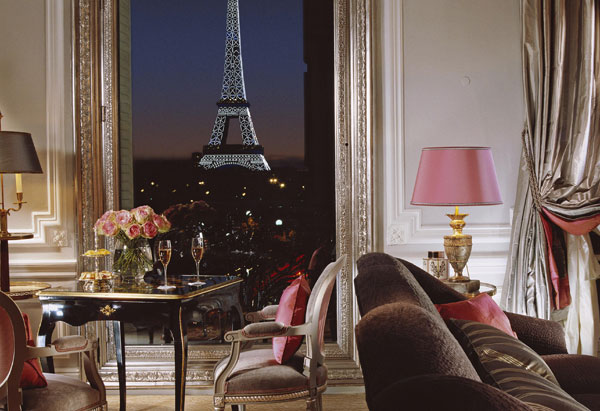
After flying business class to Paris, courtesy of OpenSkies, you'll begin your stay with two nights at Hôtel Plaza Athénée, where you'll be treated to Champagne breakfasts, dinner for two at Alain Ducasse Restaurant (recipient of three Michelin stars) and more. Then spend two nights at Hôtel Le Meurice and meet three-Michelin-star chef Yannick Alléno. Enjoy a meal at his acclaimed restaurant, receive his signed book and taste a selection of wines chosen by the head sommelier.
This contest is now closed. Thank you for entering.
 Read the itinerary for the 4-night adventure
Read the itinerary for the 4-night adventure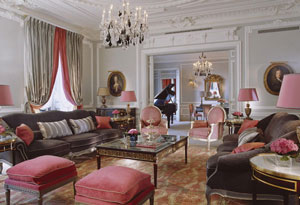 See our slideshow of the Hôtel Plaza Athénée
See our slideshow of the Hôtel Plaza Athénée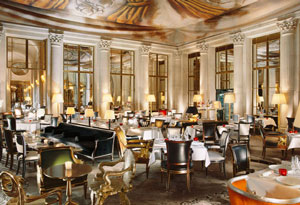 See our slideshow of Hôtel Le Meurice
See our slideshow of Hôtel Le Meurice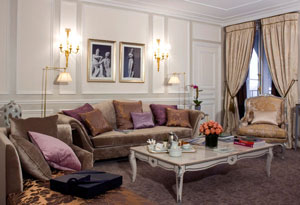 Read our Q&A with the chief concierges from both Hôtel Le Meurice and Hôtel Plaza Athénée
Read our Q&A with the chief concierges from both Hôtel Le Meurice and Hôtel Plaza AthénéeBora Bora, Italy, London and more: Read about all 5 adventures
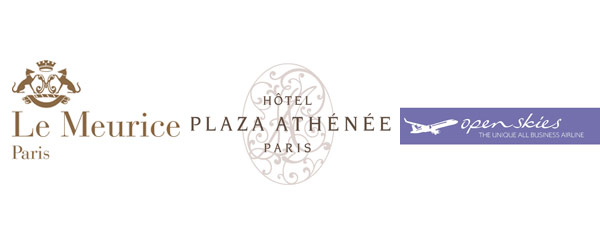
- Roundtrip Business Seat Tickets from OpenSkies from either Washington, D.C., or New York City to Paris (see Long Rules for details on travel to gateway city)
- Transportation from the airport in Paris to Hôtel Plaza Athénée
- Two nights in a Deluxe Room at Hôtel Plaza Athénée facing the famous Avenue Montaigne
- Breakfast (with Champagne) for two, every day
- One private meeting/lesson with Hôtel Plaza Athénée's "Champion of Pastries"
- One night of dinner for two in the private dining room of Alain Ducasse. Dinner includes two glasses of Champagne and one bottle of wine
- Transportation from Hôtel Plaza Athénée to Hôtel Le Meurice
- Two nights in a Charles Jouffre redesigned Suite at Hôtel Le Meurice with a view of the Tuileries Gardens
- Breakfast for two (with Champagne) every day
- Private visit of the kitchen and meeting with Yannick Alléno, the three-Michelin-star chef of Hôtel Le Meurice, plus gift of a signed copy of his book
- One lunch for two at the Restaurant Le Meurice with the Terroir Parisien menu, featuring wines selected by their sommelier
- Cocktails for two at Hôtel Le Meurice's Bar 228
- Transportation from Hôtel Le Meurice to the airport
This contest is now closed. Thank you for entering.

O talked to the chief concierge at both Hôtel Plaza Athénée and Le Meurice to find out the secrets of the city.
Head Concierge, Hôtel Plaza AthénéeO: What's your favorite view in town?
1. Fontainebleau & Barbizon
Fond of hunting here, the kings of France built a manor house, which was embellished by thirty-four successive kings, to become the grandiose Chateau de Fontainebleau in the midst of a huge forest. From 1830 to 1875, the more modest hamlet of Barbizon, on the edge of the forest, attracted a colony of landscape painters, later known as the "Barbizon School".
2. Chateau de Vaux-le-Vicomte
Three geniuses of the 17th century—the architect Le Vau, the painter and sculptor Le Brun and the landscape gardener Le Notre—combined their talents so well to create this site that Louis XIV subsequently commissioned them to work on the Chateau de Versailles. The view of the dome, the painted decor and hangings in the Salon des Muses, the borders in the French-style garden, its ornamental ponds and fountains are spellbinding.
O: What's your favorite walk to suggest to visitors?
1. Luxembourg Garden & Museum
Children love the Luxembourg gardens for their wooden horses, their model yachts to push along with a cane on the ornamental pond, for their refreshment kiosks, puppet theater, ponies, etc. Others appreciate the setting: artists with their easels, chess players, daydreamers, students with their notepads, computers. The Fontaine Médicis with all its niches and nymphs is all that remains of the Italianate grotto that Marie de Médicis had built in 1630.
2. Parc Monceau
This 18th-century Anglo-Chinese folly was one of the first irregular gardens designed like a cabinet of outdoor curiosities. Amongst the lawns and play areas, there remain some extravagances: the mock antique ruins surrounding the ornamental pond, a little bridge, a grotto, rocks and even an Egyptian tomb covered with moss!
O: What is your favorite activity to suggest to visitors?
1. National Museum of Asian Arts Guimet
The walls of the museum are decorated in subtle tones to set off the splendor of the collections. Each floor is a journey.
2. Palais de Tokyo
The spacious dimensions brightened with acid tones are a showcase for emerging contemporary art. From midday to midnight, experimental, irreverent, international and often interactive exhibitions and events brighten the lineup.
3. Modern Art Museum of Paris
The Museum of Modern Art displays the pure tones of the fauvists, the deconstructed shapes of the cubists and Les Disques by Fernand Léger. It also covers the 1950s and the following decades with the New Realism, Arte Povera, Support/Surface, Fluxus and more.
4. Maillol Foundation
Dina Vierny was the muse and friend of the painter and sculptor Aristide Maillol. The foundation and the museum reveal the work of the artist and offer a panorama of 20th century art through his collection and that of Dina.
5. Fashion Museum of Paris — Palais Galliéra
In the garden of this 19th-century palace, the fountain's nymph is dressed like Eve. Inside, lacework, parasols, haute couture labels, fans and shoes (in total 90,000 costumes and accessories) show the history of fashion with sublime temporary exhibitions.
O: Where do you send visitors looking for some peace and quiet?
Viaduct des Arts and Promenade Plantée
The walk begins in midair, on the avenue Daumesnil. A staircase leads up to the viaduct of a former railway line. Brick mansions eventually give way to the former residence of the Merovingian kings, now Jardin de Reuilly, with its half-moon-shaped lawn.
O: What mistakes do you see visitors make?
That all guests would like to eat in all the same restaurants.
O: What is your favorite historical fact or piece of trivia about the city?
Covered Arcades
At the beginning of the 19th century, Haussmann redesigned Paris. Built for the crowds thronging the café terraces and theaters along the boulevards, covered shopping arcades were a huge success with their boutiques of Chinese ornaments, curiosities and gifts, along with tea, chocolate and coffee houses. Then came the department stores. With the magic of electricity and pavements, the passageways became less fashionable and some were demolished.
Chief Concierge, Le Meurice
O: What's your favorite view in town?
Definitively Montmartre because it offers an unalterably magical view over the French capital. You can feel a typical Parisian atmosphere.
O: What's your favorite walk to suggest to visitors?
The Ile Saint Louis (it's a small island) near Notre Dame's Cathedral. It's almost as if someone dropped a small French village into the center of Paris, as it features markets, bakeries, cheese shops and cafés. This is also the place where you can eat the famous Berthillon's ice cream. Moreover, I enjoy "Les Buttes Chaumont" where you have a beautiful garden. It's in the 19th district, northwest of Paris. It's not a touristic area, and you really have to visit it for one or two hours. The park is the third largest of its kind in Paris. The main feature is the Belvedere (or Temple) of Sybille which sits at the top of an island in the middle of a lake.
O: What is your favorite activity to suggest to visitors?
To discover Paris on foot. You always have surprises when you walk in this city. The history is so important that even if you live here, you always discover new places and things. The hotel is the perfect place for those who like shopping and visiting museums as it is surrounded by the most famous ones (Le Louvre, Le Musée d'Orsay, le Musée du Jeu de Paume, le Musée des Arts Décoratifs...).
O: Where do you send visitors looking for some peace and quiet?
The Bagatelle Park is like an oasis from the rush of the city. Created in the 18th century at the heart of the Bois de Boulogne, the beautiful de Bagatelle is laid out in the Anglo-Chinese style. It's landscaped in a determinedly romantic fashion and features charmingly bucolic scenes with waterfalls, grottoes, little bridges and a Chinese pagoda.
O: What is your favorite historical fact or piece of trivia about the city?
The historical place to discover is the "Lutecia Arena" in the Latin area. It dates back to the 2nd century A.D. The remains of the Roman amphitheater of Paris, discovered in 1869, give an idea of the original structure. It could accommodate an audience of 17,000. It's amazing to think that gladiator and animal fights were staged in this place. In front of Le Meurice, we also see the Louvre Museum which used to be a castle a long time ago and the Tuileries Garden which used to be the garden of the royalty. The history is everywhere in Paris!
This contest is now closed. Thank you for entering.





